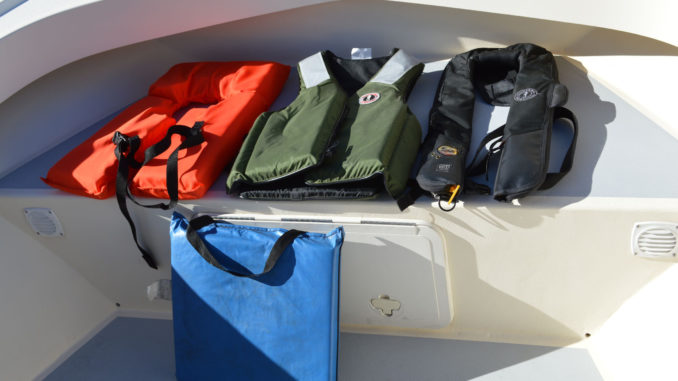
Different styles of life jackets are best suited for different uses, but all will save lives
Kyle Young, an enforcement officer with the N.C. Wildlife Resources Commission, makes plenty of points during his boater-safety classes, but one underscores the importance of personal flotation devices: 90 percent of drowning victims in boat accidents weren’t wearing one.
Wearing a PFD is especially important when the water turns cold, increasing the risk of hypothermia. Waterfowl hunters and anglers know they need a PFD, but do they know which one? Finding the proper one comes down to intended use, comfort and the law.
PFDs are divided into two categories — inflatable and inherently buoyant. Those in the first category inflate automatically when submerged or manually when the user yanks a cord. They are comfortable and don’t inhibit shooting or casting. The second category includes life vests, flotation jackets and the orange “horse collar” models. They usually are cheaper than inflatables but are bulky and restrict movement.
“Finding a life jacket that you’ll wear and maintain is the most important thing, and that it’s appropriate for what you’re doing,” said Gabe Doring, who designs Onyx PFDs for Absolute Outdoors Inc. of Sauk Rapids, Minn. It sells more inherently buoyant PFDs, he said, but inflatable sales are surging.
While inherently buoyant PFD use is straight forward, inflatables have peculiarities. A common concern with them is accidental inflation, which Doring said happens most often to automatics while stored in a damp boat locker.
“I’ve never had it go off from spray or rain, and I’ve been in some terrible rainstorms in a boat,” Doring said.
Sustained high humidity can affect an automatic’s water-soluble bobbin, which controls the carbon dioxide cartridge that inflates the PFD. He suggests outdoorsmen replace the bobbin annually. Waterfowl hunters who choose an inflatable PFD should use a manual model to avoid accidental inflations while wading or hiding in a wet blind. Inflatables are not recommended in temperatures below freezing – because cold hampers inflation – or for watersports, poor swimmers and those younger than 16. Inherently buoyant PFDs are better for them.
PFD sizes are based on chest size and body weight, Young said. A life jacket must fit snuggly. If it needs just a tug to slide up, it’s too big or needs adjusting — snug the bottom buckle first then move up, Doring said.
The U.S. Coast Guard labels every PFD as one of five types. Hunters and anglers usually choose a Type I, which provide the most buoyancy; Type II, such as the orange horse-collar models; or Type III, such as vests and many inflatables. Type V PFDs are designed for specific uses such as whitewater rafting. North Carolina PFD regulations are based on these designations.
“Each vessel is required to have at least one PFD per person,” Young said, and it needs to be a Type I, II or III. “In order for an inflatable to count toward your number of life vests on board, it needs to be worn.”
If an inflatable PFD is removed while fishing, as anglers often do, an inheritably buoyant PFD is needed on board to be compliant. Motorized boats 16 feet or longer must have a Type IV, which is a throwable flotation device. Passengers younger than 13 must wear a PFD when the vessel is underway, unless below deck or inside an enclosed cabin. Anyone riding on or behind a personal watercraft must wear an inherently buoyant PFD.
South Carolina boating law requires a PFD for each passenger and a Type IV for boats 16 feet and longer. A PFD must be worn by passengers younger than 12 on boats shorter than 16 feet. Every PWC rider needs one.
Both states require PFDs that are in good condition and accessible. The most common PFD errors Young sees during boat checks are life jackets buried in a locker or a forgotten location. “You want them to be ready when you need them,” he said.



Be the first to comment